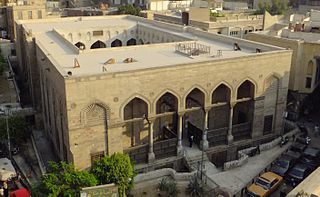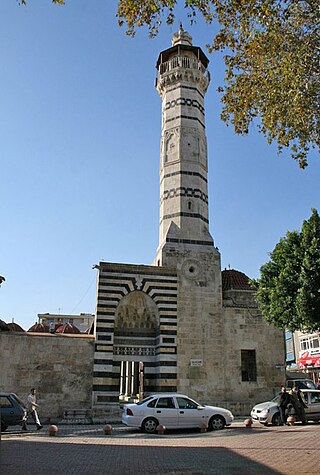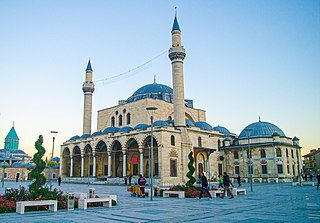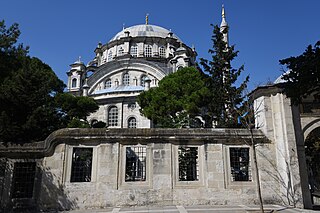
The Mosque of al-Salih Tala'i is a late Fatimid-era mosque built by the vizier Tala'i ibn Ruzzik in 1160. It is located south of Bab Zuweila, just outside the southern entrance to the old walled city of Cairo.

The Eyüp Sultan Mosque is a mosque in Eyüp district of Istanbul, Turkey. The mosque complex includes a mausoleum marking the spot where Ebu Eyüp el-Ansari, the standard-bearer and companion of the Islamic prophet Muhammad, is said to have been buried. On a much older site, the present building dates from the beginning of the 19th century.

Divriği Great Mosque and Hospital was built in 1228–1229 by the local dynasty of the Mengujekids in the small Anatolian town of Divriği, now in Sivas Province, Turkey. The complex is in the upper town, below the citadel. The exquisite stone carvings and eclectic architecture of the complex places it among the most important works of architecture in Anatolia and led to its inclusion on UNESCO's World Heritage List in 1985.

Turkish art refers to all works of visual art originating from the geographical area of what is present day Turkey since the arrival of the Turks in the Middle Ages. Turkey also was the home of much significant art produced by earlier cultures, including the Hittites, Ancient Greeks, and Byzantines. Ottoman art is therefore the dominant element of Turkish art before the 20th century, although the Seljuks and other earlier Turks also contributed. The 16th and 17th centuries are generally recognized as the finest period for art in the Ottoman Empire, much of it associated with the huge Imperial court. In particular the long reign of Suleiman the Magnificent from 1520 to 1566 brought a combination, rare in any ruling dynasty, of political and military success with strong encouragement of the arts.

The Alâeddin Mosque is the principal monument on Alaaddin Hill in the centre of Konya, Turkey. Part of the hilltop citadel complex that contained the Seljuk Palace, it served as the main prayer hall for the Seljuk Sultans of Rum and its courtyard contains the burial places of several of the sultans. It was constructed in stages between the mid-12th and mid-13th centuries. It is the largest of several Seljuk mosques to survive in Konya.

Sabancı Merkez Camii in Adana is the second largest mosque in Turkey. The exterior of the mosque is similar to the Selimiye Mosque in Edirne, though it has six minarets, similar to the Sultan Ahmed Mosque in Istanbul.

Al-Zaytuna Mosque, also known as Ez-Zitouna Mosque, and El-Zituna Mosque, is a major mosque at the center of the Medina of Tunis in Tunis, Tunisia. The mosque is the oldest in the city and covers an area of 5,000 square metres with nine entrances. It was founded at the end of the 7th century or in the early 8th century, but its current architectural form dates from a reconstruction in the 9th century, including many antique columns reused from Carthage, and from later additions and restorations over the centuries. The mosque hosted one of the first and greatest universities in the history of Islam. Many Muslim scholars graduated from al-Zaytuna for over a thousand years. Ibn 'Arafa, a major Maliki scholar, al-Maziri, the great traditionalist and jurist, and Aboul-Qacem Echebbi, a famous Tunisian poet, all taught there, among others.

The Great Mosque of Adana, also known as the Ramazanoglu Mosque, is a 16th-century mosque in Adana, Turkey. It forms part of a complex (külliye) that includes a madrasah and a mausoleum (türbe). The complex is on Kızılay Street, next to the Ramazanoğlu Hall.

The Grand Mosque of Bursa is a historic mosque in Bursa, Turkey. It was commissioned by the Ottoman Sultan Bayezid I to commemorate his great victory at the Battle of Nicopolis and built between 1396 and 1399. The mosque is a major monument of early Ottoman architecture and one of the most important mosques in the city, located in the heart of the old city alongside its historic markets.

Anatolian Seljuk architecture, or simply Seljuk architecture, refers to building activity that took place under the Sultanate of Rum, ruled by an offshoot of the Seljuk dynasty that emerged from the Great Seljuk Empire alongside various other local dynasties. The Anatolian Seljuks patronized their own tradition of architecture whose surviving examples are generally found in present-day Turkey. Anatolian Seljuk architecture was eclectic and influenced by multiple traditions including Armenian, Byzantine, Iranian, and Syrian architecture. Unlike earlier Great Seljuk architecture to the east, their buildings were generally constructed in stone and featured significant stone-carved decoration as well as tile decoration. While the Seljuk Sultanate declined and ended in the late 13th century, architecture continued to flourish and diversify under the smaller Beylik states in Anatolia, which included the early Ottomans.

Eşrefoğlu Mosque is a 13th-century mosque in Beyşehir, Konya Province, Turkey It is situated 100 metres (330 ft) north of the Beyşehir Lake

Selimiye Mosque is a 16th-century Ottoman mosque in Konya, Turkey.

The Selimiye Mosque is a mosque in the district of Üsküdar in Istanbul, Turkey, near the Selimiye Barracks. It was commissioned by Ottoman Sultan Selim III and built between 1801 and 1805.

Turunçlu Mosque, also known as Turunçlu Fethiye Mosque is a mosque in the Iplik Bazar–Korkut Effendi quarter in the walled city of Nicosia, currently located in North Nicosia. It dates to the Ottoman period. It is located on Beliğ Paşa Street.

Bayraktar Mosque is a mosque in Nicosia, Cyprus, currently placed in the southern sector of the city administered by the Republic of Cyprus.

The Kasbah Mosque, also known as the Moulay al-Yazid Mosque, is a historic mosque in Marrakesh, Morocco. It was originally built by the Almohad ruler Yaqub al-Mansur in 1185–1190 CE. It is located in the Kasbah district, the city's former citadel, near the site of its historic royal palaces. Along with the Kutubiyya Mosque, it is one of the most important historic mosques in Marrakesh.

Sivrihisar Grand Mosque is a historical mosque in Sivrihisar, Turkey.

Laleli Mosque is a mosque in the Abdi Çavuş quarter of the walled city of Nicosia, currently located in North Nicosia. It is located on Ali Ruhi Street. Its name, meaning "the Mosque with Tulips", is thought to be derived from the tulip motifs adorning its original minaret. Originally a small medieval chapel, it was enlarged and converted to a mosque in the 19th century.

The Great Mosque of Sivas is a historic mosque located in Sivas, Turkey. It was built in the 12th century and is the oldest surviving building in the city. Its minaret was built in the early 13th century.

The Ayazma Mosque is a mosque in the neighbourhood of Üsküdar in Istanbul, Turkey. It stands on a hillside overlooking the Bosphorus. It was commissioned by Ottoman Sultan Mustafa III and built between 1757 and 1761. It is an example of the Ottoman Baroque style that was prevalent in the 18th century.




































